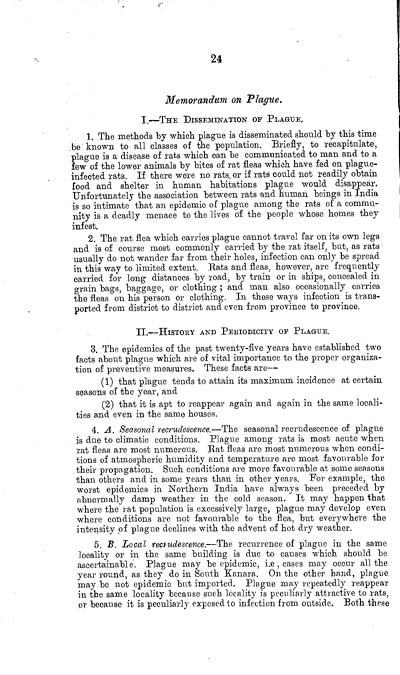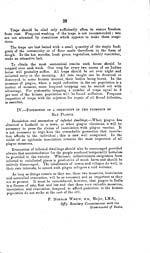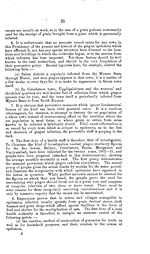Medicine - Disease > Madras plague regulations in force outside the Presidency town > Volume 7
(30) Page 24
Download files
Individual page:
Thumbnail gallery: Grid view | List view

24
Memorandum on Plague.
I.-THE DISSEMINATION OF PLAGUE.
1. The methods by which plague is disseminated should by this time
be known to all classes of the population. Briefly, to recapitulate,
plague is a disease of rats which can be communicated to man and to a
few of the lower animals by bites of rat fleas which have fed on plague-
infected rats. If there were no rats or if rats could not readily obtain
food and shelter in human habitations plague would disappear.
Unfortunately the association between rats and human beings in India
is so intimate that an epidemic of plague among the rats of a commu-
nity is a deadly menace to the lives of the people whose homes they
infest.
2. The rat flea which carries plague cannot travel far on its own legs
and is of course most commonly carried by the rat itself, but, as rats
usually do not wander far from their holes, infection can only be spread
in this way to limited extent. Rats and fleas, however, are frequently
carried for long distances by road, by train or in ships, concealed in
grain bags, baggage, or clothing; and man also occasionally carries
the fleas on his person or clothing. In these ways infection is trans-
ported from district to district and even from province to province.
II.-HISTORY AND PERIODICITY OF PLAGUE.
3. The epidemics of the past twenty-five years have established two
facts about plague which are of vital importance to the proper organiza-
tion of preventive measures. These facts are-
(1) that plague tends to attain its maximum incidence at certain
seasons of the year, and
(2) that it is apt to reappear again and again in the same locali-
ties and even in the same houses.
4. A. Seasonal recrudescence.-The seasonal recrudescence of plague
is due to climatic conditions. Plague among rats is most acute when
rat fleas are most numerous. Rat fleas are most numerous when condi-
tions of atmospheric humidity and temperature are most favourable for
their propagation. Such conditions are more favourable at some seasons
than others and in some years than in other years. For example, the
worst epidemics in Northern India have always been preceded by
abnormally damp weather in the cold season. It may happen that
where the rat population is excessively large, plague may develop even
where conditions are not favourable to the flea, but everywhere the
intensity of plague declines with the advent of hot dry weather.
5. B. Local recrudescence.-The recurrence of plague in the same
locality or in the same building is due to causes which should be
ascertainable. Plague may be epidemic, i.e, cases may occur all the
year round, as they do in South Kanara. On the other hand, plague
may be not epidemic but imported. Plague may repeatedly reappear
in the same locality because such locality is peculiarly attractive to rats,
or because it is peculiarly exposed to infection from outside. Both these
Memorandum on Plague.
I.-THE DISSEMINATION OF PLAGUE.
1. The methods by which plague is disseminated should by this time
be known to all classes of the population. Briefly, to recapitulate,
plague is a disease of rats which can be communicated to man and to a
few of the lower animals by bites of rat fleas which have fed on plague-
infected rats. If there were no rats or if rats could not readily obtain
food and shelter in human habitations plague would disappear.
Unfortunately the association between rats and human beings in India
is so intimate that an epidemic of plague among the rats of a commu-
nity is a deadly menace to the lives of the people whose homes they
infest.
2. The rat flea which carries plague cannot travel far on its own legs
and is of course most commonly carried by the rat itself, but, as rats
usually do not wander far from their holes, infection can only be spread
in this way to limited extent. Rats and fleas, however, are frequently
carried for long distances by road, by train or in ships, concealed in
grain bags, baggage, or clothing; and man also occasionally carries
the fleas on his person or clothing. In these ways infection is trans-
ported from district to district and even from province to province.
II.-HISTORY AND PERIODICITY OF PLAGUE.
3. The epidemics of the past twenty-five years have established two
facts about plague which are of vital importance to the proper organiza-
tion of preventive measures. These facts are-
(1) that plague tends to attain its maximum incidence at certain
seasons of the year, and
(2) that it is apt to reappear again and again in the same locali-
ties and even in the same houses.
4. A. Seasonal recrudescence.-The seasonal recrudescence of plague
is due to climatic conditions. Plague among rats is most acute when
rat fleas are most numerous. Rat fleas are most numerous when condi-
tions of atmospheric humidity and temperature are most favourable for
their propagation. Such conditions are more favourable at some seasons
than others and in some years than in other years. For example, the
worst epidemics in Northern India have always been preceded by
abnormally damp weather in the cold season. It may happen that
where the rat population is excessively large, plague may develop even
where conditions are not favourable to the flea, but everywhere the
intensity of plague declines with the advent of hot dry weather.
5. B. Local recrudescence.-The recurrence of plague in the same
locality or in the same building is due to causes which should be
ascertainable. Plague may be epidemic, i.e, cases may occur all the
year round, as they do in South Kanara. On the other hand, plague
may be not epidemic but imported. Plague may repeatedly reappear
in the same locality because such locality is peculiarly attractive to rats,
or because it is peculiarly exposed to infection from outside. Both these
Set display mode to: Large image | Zoom image | Transcription
Images and transcriptions on this page, including medium image downloads, may be used under the Creative Commons Attribution 4.0 International Licence unless otherwise stated. ![]()
| India Papers > Medicine - Disease > Madras plague regulations in force outside the Presidency town > Volume 7 > (30) Page 24 |
|---|
| Permanent URL | https://digital.nls.uk/74592258 |
|---|---|




